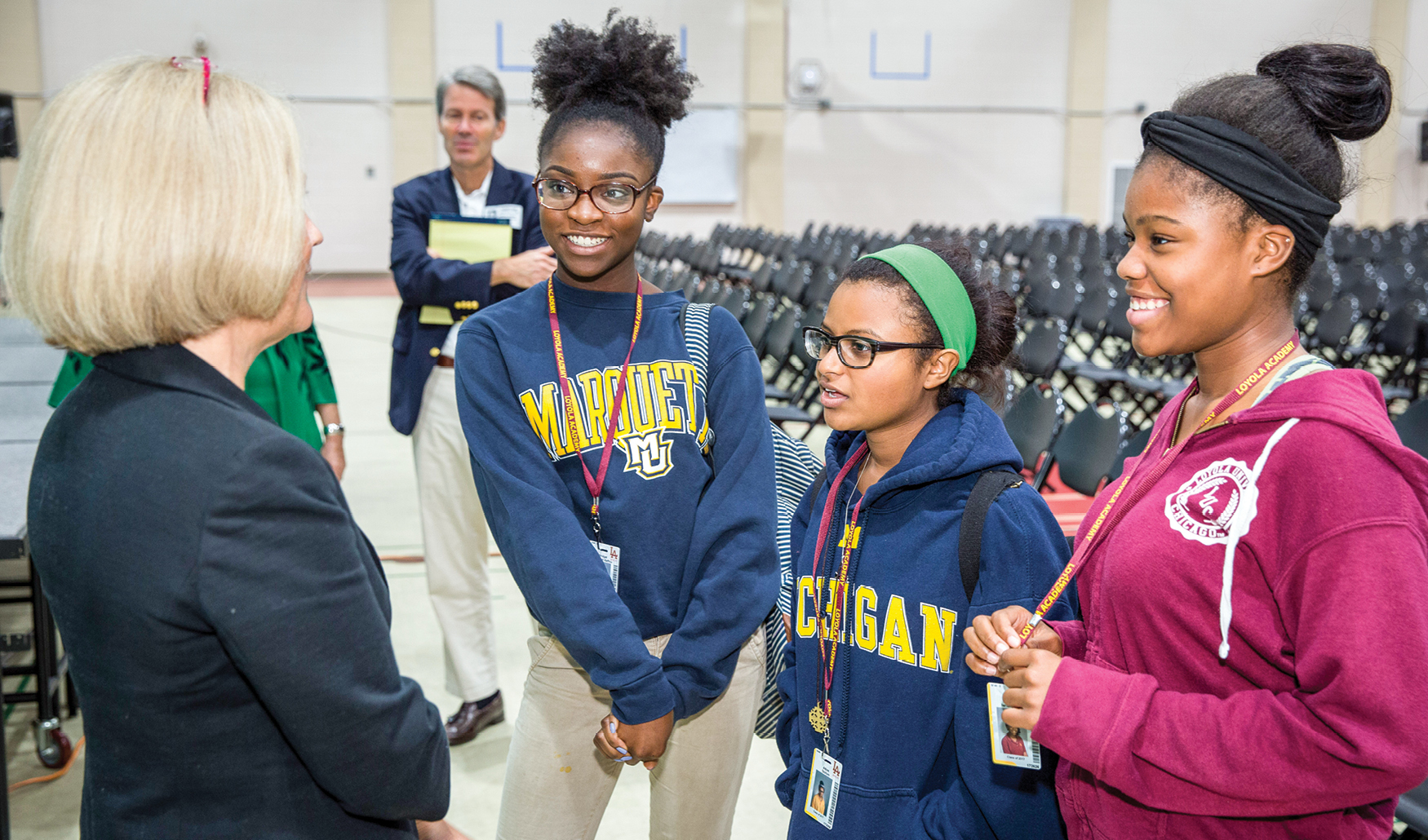
The Developing Teenage Brain
Q&A with Frances Jensen, a leading neurologist, on the paradox of the strengths and vulnerabilities of adolescents’ brains
BY LIZ GRIFFIN/
School Administrator, September 2017

|
| Frances Jensen, M.D. |
When her teenage son, Andrew, informed her he wanted to add red streaks to his hair, Frances Jensen recalls that she first “calmed” herself before offering to take him to her own hair stylist. Several years later, another son, Will, squeezed an impulsive left turn into oncoming traffic and totaled the car. At that moment, Jensen experienced a flashback, thinking “Here we go again.” This time, she says she was better prepared for dealing with “classic” teenage behavior, having read a considerable amount of the latest research on the functioning of the adolescent brain.
Jensen is a neurologist and neuroscientist with 30 years of experience studying children’s brain development at Harvard Medical School before becoming chair of the department of neurology at the University of Pennsylvania’s Perelman School of Medicine. She holds a researcher’s fascination with the mysteries of the teenage brain and shares her understanding with educators, parents, young adults and teens.
The emerging findings and research data, along with her personal insights and anecdotes, have been woven into her latest book,
The Teenage Brain: A Neuroscientist’s Survival Guide to Raising Adolescents and Young Adults (Harper Collins, 2015). Once a largely neglected area of study, the teen brain is gaining rich attention.
In a recent interview with
School Administrator, Jensen explores the teenage brain, its spectacular learning power and vulnerabilities, and some ways educators and teenagers might apply this knowledge to build on strengths and shore up weaknesses in its functioning.
This interview has been edited for clarity and length.
You liken the adolescent brain to a Ferrari without brakes. What do you mean by that?
JENSEN: Adolescents will learn things faster and more easily than they ever will again. It’s extraordinary! Every area of their brains is more active than adults. It’s a point in brain development when nature has set the machinery for learning at very high levels.
Teens have more brain cells or neurons than adults do and are better at building brain connections, or synapses, than adults are. The process of molding the brain is called
synaptic plasticity. These synapses are the crucial juncture where one cell passes information to another so learning can occur.
Teens go through a period of increased emotional fluctuation and are like a Ferrari with weak brakes. The emotional center of the brain, the limbic system, which controls emotions, is fully connected, but the frontal lobe that sharpens critical thinking isn’t well-connected. That means the part of the brain that makes them pause and say to themselves, “Bad idea. Don’t post that on Facebook because it might hurt my chances of getting a job in the future” or “don’t jump in the lake, there may be a rock,” isn’t mature.
It’s a period when we as adults must be watchful. There is biology behind these poor decisions. Adolescence is a developmental period, and I tell parents and educators that, sometimes, teenagers desperately need a frontal-lobe assist.
How does the adolescent’s brain differ from an adult’s?
JENSEN: New brain imaging shows us that brain connections are built from back to front beginning with the most elementary functions (walking, eating, breathing) at the back and the more eloquent, higher-order functions (thinking and decision making) in the frontal lobes.
Executive function is an advanced skillset that includes setting priorities, using judgment and understanding cause and effect. Adolescents are better at building synapses than adults. They are fast learners but poor decision makers. Teens’ lack of connections to the frontal lobes means they have trouble abstracting issues and making decisions in real time as rapidly as adults. This is why they can be geniuses on their SATs but forget to write their homework assignment in their planner.
Adolescence is a paradox. Teenagers are programmed for peak learning but their skills such as attention, task completion, self-discipline and controlling emotions are still inefficient.
Students today are under a lot of stress. What advice do you give?
JENSEN: We now know that when adolescents are stressed or fearful, their limbic system is activated
twice as high as a child’s or adult’s. In the moment, their reaction to small things is the way our adult brains would react to an international incident.
I hope we can engender greater understanding in adults and realize that ridiculing or criticizing their behavior will likely make matters worse. It may alienate them.
Why is pruning and growth critical to the adolescent brain and learning?

|
| Neuroscientist Frances Jensen (left) meets with students at Loyola Academy in Wilmette, Ill. |
JENSEN: Nature builds a brain that is customized to its environment. When we learn a new skill or recall a memory or idea, the brain’s synapses grow and are strengthened. When synapses are not used, they wither and die. It’s the use-it-or-lose-it principle.
Losing brain connections may sound like a bad idea. But the brain has one trillion synapses, which is a large surplus. Pruning in adolescence makes the brain’s circuitry more efficient so it’s a leaner, meaner learning machine.
The brain also becomes more efficient during a process called myelination. This is when a fatty substance called myelin grows slowly and wraps itself around miles of brain cells to better insulate them. Insulation makes the brain more efficient at sending and receiving signals. Myelination is a slow process that finishes in the mid-20s.
What do brain images show us?
JENSEN: Our brains have thousands of miles of networks and to insulate all of them with myelin takes over 2 1/2 decades to finish. In functional MRI images, you can actually see the brain is laying down a layer of myelin over time when looked at year over year. You can measure those layers and see a dynamic process where the insulation is sharpening the rapidity of our signaling from one part of our brain to another. It’s very cool.
What does science say about gender differences and individual differences between brains?
JENSEN: In adolescence, on average girls are more developed by about two to three years in terms of the peak of their synapses and in their connectivity processes. Of course, some boys mature early and some girls are slow to do so. This fact is no surprise to most people if we think of 15-year-old boys and girls.
The truth is girls may be only
relatively more organized than boys because the myelination process is further along, so both teenage girls and boys can benefit from educators’ added attention to developing executive functions.
Currently, testing to pinpoint weaknesses and strengths is administered to the bottom 20 percent of students who are struggling. Wouldn’t it also be great if kids knew their strengths and weaknesses? If they knew the problem was trouble decoding or if they knew they were visual learners? Ideally, brain research could apply to individualizing curriculum so all students can reach their best potential.
What does nature and nurture mean for IQ growth?
JENSEN: We used to think IQ was fixed at puberty. But we have great data now that show adolescence is a window where teenagers have incredible neural plasticity, and they can increase their IQ. Brain development responds to nature and nurture. We know experts build more synapses in areas of the brain where they’re an expert. This process continues through adolescence.
That means high school teachers are teaching students at a time when their brains are being modified in really profound ways. Adolescents can be encouraged to build out synapses and become experts. This is a time they can hone academic and athletic skill sets. Teenagers love knowing this stuff.
You’ve talked more about peer pressure and the adolescent brain, especially bullying.
JENSEN: We need to have conversations with kids about how to protect themselves if a bully approaches them. What should they say? We all learn through trial and error, and schools could create safe places for kids to practice and make mistakes.
We know adolescents are great learners. But in the heat of the moment, they can’t abstract and foresee what may happen. It’s hard for them to respond. Teens’ brains are not going to have those words ready when that happens unless they have a rote-learned response.
Perhaps educators could guide conversations and thinking. They might ask: “What will you say when that person starts to bully you?” Role playing or a video game or a virtual app could allow them to rehearse repeatedly.
The potent tools of today’s online environment pose dangers to adolescents. What are your thoughts?
JENSEN: Educators need to have conversations with teenagers about how to manage themselves in an online environment. Inappropriate posts can travel instantly around the world. Teens are at an age when they act impulsively. That is what they do. They make mistakes and the consequences can be serious.
In earlier generations, pranks and bullying had more limited impact. But today, adolescents are playing with fire. We all know the tragedy of the Rutgers student who committed suicide after his roommate posted a video of him having sex. That act screamed “adolescent brain” all over it.
It greatly concerns me. This is the first generation that has been exposed to this level of information and stimulation (digital invasion) coming at them. Teenagers need to be engaged with adults in helping determine how to manage the panoply of input and options.
What does research say about teenage performance and the school schedule?
JENSEN: Teenagers’ circadian rhythm is different than adults; the chemical melatonin is released about two hours later (around 11 p.m.) compared with 9 p.m. for adults. Most teenagers are chronically sleep-deprived, which increases stress and impacts memory.
School systems should consider modifying the school day to begin later, or schedule study halls, sports or meditation classes at 7:30 a.m., and the harder classes at 10 a.m.
How might educators apply their knowledge about the adolescent brain?
JENSEN: Educators are still thinking about how to apply our knowledge. There are many issues when it comes to how people learn, what time the school day should start, how personalized learning should be tailored, the implications of gender differences and what it means for bullying.
Teenagers are appropriately self-absorbed, and they love to learn about themselves. I believe adding information about the adolescent brain could give them some insights into themselves. As learners, they can realize they have weaknesses at this point in their lives and vulnerabilities, such as poor executive functions or susceptibility to addiction. It may help them make better decisions. Teenagers also may be rather relieved to learn why they did that stupid, impulsive thing on Saturday night and that they will be less prone to impulsive behavior as their brain matures.
LIZ GRIFFIN is managing editor of School Administrator. E-mail:
lgriffin@aasa.org
Additional Resources
Author Frances Jensen recommends these informational resources for understanding the unique strengths and weaknesses of the adolescent brain.
» “Adolescence as a Sensitive Period of Brain Development” by Delia Fuhrmann, Lisa J. Knoll and Sarah-Jayne Blakemore,
Trends in Cognitive Sciences, October 2015.
» “Adolescent Neuroscience of Addiction: A New Era” by Jay N. Giedd,
Developmental Cognitive Neuroscience, December 2015.
» “
The Amazing Teen Brain” by Jay N. Giedd,
Scientific American, June 2015.
» “The Development of Social Cognition in Adolescence: An Integrated Perspective” by Emma J. Kilford, Emily Garrett and Sarah-Jayne Blakemore,
Neuroscience & Biobehavioral Reviews, November 2016.
»
The Teenage Brain: A Neuroscientist’s Survival Guide to Raising Adolescents by Frances E. Jensen, Harper Paperbacks, New York, N.Y., 2015.